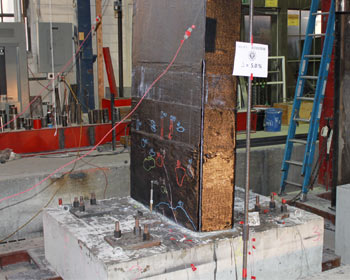Research Reports
Report Details
Abstract
 Reinforced concrete bridge wall piers constructed using older codes perform inadequately during strong earthquakes; deficiencies include short reinforcement lap splices, insufficient steel reinforcement ratios in the longitudinal and transverse direction, and inadequate seismic detailing. Three half-scale wall piers were constructed using as-built reinforcement details conforming to older bridge codes; an identical fourth specimen was constructed using current seismic code-compliant reinforcement details. A total of six quasi-static cyclic tests were conducted regarding the weak axis of the wall piers: (i) as-built test of first wall pier, (ii) test of modern code-compliant pier, (iii) retrofit test of second as-built pier using vertical and horizontal CFRP anchors and jackets (R1), (iv) retrofit test of third as-built pier using near surface mounted (NSM) carbon fiber reinforced polymer (CFRP) rods, horizontal CFRP anchors and jackets (R2), (v) repair test of first as-built pier using mild steel NSM bars, horizontal CFRP anchors and jackets (ABRP), and (vi) repair test of code-compliant pier using a CFRP shell with vertical headed steel bars for relocating the plastic hinge (MCRP). The two retrofit methods increased initial stiffness of the as-built pier by 110%, the lateral load-carrying capacity by 73%, and the hysteretic energy dissipation capacity by 67%. The repair method of the as-built pier increased initial stiffness of the as-built pier by 50% and load-carrying capacity by 73% with similar hysteretic energy dissipation. The repair method of the code-compliant pier increased the initial stiffness by 31%, load-carrying capacity by 15%, and hysteretic energy capacity by 55% for lateral displacements that reached a 6% drift ratio.
Reinforced concrete bridge wall piers constructed using older codes perform inadequately during strong earthquakes; deficiencies include short reinforcement lap splices, insufficient steel reinforcement ratios in the longitudinal and transverse direction, and inadequate seismic detailing. Three half-scale wall piers were constructed using as-built reinforcement details conforming to older bridge codes; an identical fourth specimen was constructed using current seismic code-compliant reinforcement details. A total of six quasi-static cyclic tests were conducted regarding the weak axis of the wall piers: (i) as-built test of first wall pier, (ii) test of modern code-compliant pier, (iii) retrofit test of second as-built pier using vertical and horizontal CFRP anchors and jackets (R1), (iv) retrofit test of third as-built pier using near surface mounted (NSM) carbon fiber reinforced polymer (CFRP) rods, horizontal CFRP anchors and jackets (R2), (v) repair test of first as-built pier using mild steel NSM bars, horizontal CFRP anchors and jackets (ABRP), and (vi) repair test of code-compliant pier using a CFRP shell with vertical headed steel bars for relocating the plastic hinge (MCRP). The two retrofit methods increased initial stiffness of the as-built pier by 110%, the lateral load-carrying capacity by 73%, and the hysteretic energy dissipation capacity by 67%. The repair method of the as-built pier increased initial stiffness of the as-built pier by 50% and load-carrying capacity by 73% with similar hysteretic energy dissipation. The repair method of the code-compliant pier increased the initial stiffness by 31%, load-carrying capacity by 15%, and hysteretic energy capacity by 55% for lateral displacements that reached a 6% drift ratio.
How to Cite
Pantelides, Chris P., Bhaskar Kunwar, and Vanessa McEntee. Seismic Rehabilitation of Reinforced Concrete Bridge Wall Piers, MPC-19-410. North Dakota State University - Upper Great Plains Transportation Institute, Fargo: Mountain-Plains Consortium, 2019.